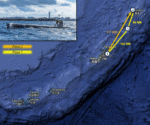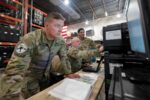The arrival of a Japan Air Self-Defense Force (JASDF) Kawasaki C-2 at RAF Brize Norton marks a significant milestone in growing UK-Japan defense ties. The deployment is part of the “Atlantic Eagles” initiative aimed at enhancing bilateral interoperability and showcasing Japan’s strategic airlift capabilities in Europe.
Strategic Context of the Atlantic Eagles Initiative
The deployment of the JASDF’s Kawasaki C-2 to the United Kingdom under the Atlantic Eagles program represents a deliberate step by Tokyo and London toward strengthening defense-industrial and operational ties. Announced in 2023 as part of broader UK-Japan defense cooperation—including the Global Combat Air Programme (GCAP)—Atlantic Eagles focuses on joint air mobility exercises and logistical interoperability.
This initiative aligns with Japan’s evolving security posture under its 2022 National Security Strategy, which emphasizes proactive contributions to international stability, including through overseas deployments. For the UK, it reinforces its “Indo-Pacific tilt” policy outlined in its Integrated Review Refresh 2023, seeking deeper engagement with key regional partners like Japan.
Kawasaki C-2: Capabilities and Role
The Kawasaki C-2 is a twin-engine jet-powered strategic transport aircraft developed by Kawasaki Heavy Industries (KHI) for the JASDF. Designed to replace aging Lockheed C-1 and complement or eventually replace some missions currently handled by the larger Boeing KC-767J fleet, it offers substantial improvements in payload capacity, range, and avionics.
- Payload: Up to 37.6 tonnes (versus ~20 tonnes for legacy platforms)
- Range: Approximately 7,600 km with standard payload
- Cargo hold dimensions: Comparable to Boeing C-17A Globemaster III
- Avionics: Fly-by-wire controls; integrated digital cockpit; GPS/INS navigation
The aircraft can carry main battle tanks (such as Type 10), helicopters (e.g., UH-60), or multiple pallets of humanitarian aid or ammunition. It also supports aerial delivery operations via rear cargo ramp. Although not equipped for aerial refueling as standard, studies have been conducted on extending its endurance through future upgrades.
Deployment Details and Operational Objectives
The JASDF C-2 arrived at RAF Brize Norton on September 17 after transiting via Dubai Al Maktoum International Airport. The aircraft belongs to the JASDF’s 403rd Tactical Airlift Squadron based at Miho Air Base in Tottori Prefecture. This marks its first operational deployment to Europe outside of international airshows like Farnborough or RIAT.
During its stay in the UK—expected to last several weeks—the aircraft will participate in combined logistics drills with Royal Air Force A400M Atlas and C-17 units. Key training objectives include:
- Ground handling interoperability between Japanese crews and RAF logistics personnel
- Cargo loading/unloading procedures using NATO-standard equipment
- Tactical routing exercises over European airspace with simulated mission profiles
No live cargo missions are expected during this rotation; however, observers note that future iterations could include real-world logistics tasks supporting UN peacekeeping or disaster relief scenarios.
UK-Japan Defense Cooperation Expands Beyond GCAP
This deployment follows several high-profile developments in UK-Japan defense relations:
- Global Combat Air Programme (GCAP): Joint development of sixth-generation fighter jet with Italy; full-scale prototype expected by ~2030.
- AUKUS Pillar II discussions: While not formal members of AUKUS, Japanese officials have engaged informally on advanced technology sharing frameworks.
- Bilateral defense agreements: The Reciprocal Access Agreement (RAA), signed January 2023, facilitates mutual troop deployments for training/exercises without lengthy diplomatic clearances.
The presence of Japanese military assets on British soil underlines growing trust between two technologically advanced democracies seeking greater global reach without relying solely on U.S.-led frameworks. For Tokyo especially—constitutionally constrained from traditional power projection—the use of long-range platforms like the C-2 serves both symbolic and practical ends.
Kawasaki’s Export Ambitions and Market Positioning
Kawasaki Heavy Industries has previously expressed interest in exporting the C-2 platform but faces stiff competition from established Western models such as Lockheed Martin’s C-130J Super Hercules or Airbus’ A400M Atlas. However, niche opportunities may exist where countries require higher payload than a tactical lifter but cannot afford or justify a full-size strategic platform like the Boeing C-17A (now out of production).
The Atlantic Eagles deployment serves as an implicit marketing demonstration—showcasing reliability over intercontinental distances and compatibility with NATO infrastructure—to potential buyers or partners such as Australia or Middle Eastern states exploring diversification beyond U.S.-centric supply chains.
Outlook: Toward Regularized Interoperability Rotations?
If successful, Atlantic Eagles could evolve into an annual or semiannual rotational program involving reciprocal visits by RAF assets to Japanese bases such as Miho or Iruma. Such exchanges would deepen familiarity between ground crews while testing logistical concepts relevant for coalition operations across Indo-Pacific flashpoints or European contingencies alike.
This initial deployment is modest—but strategically meaningful—as both nations recalibrate their force postures amid rising global instability. For Japan especially, it signals increasing comfort with projecting military capabilities abroad within multilateral frameworks aligned with democratic partners.









